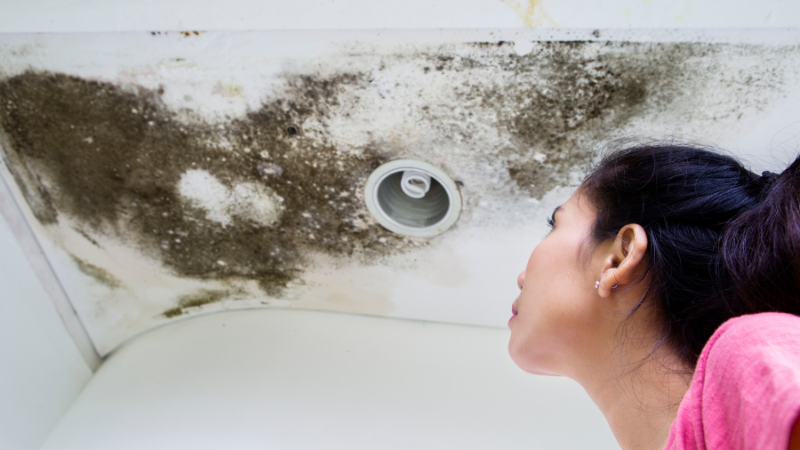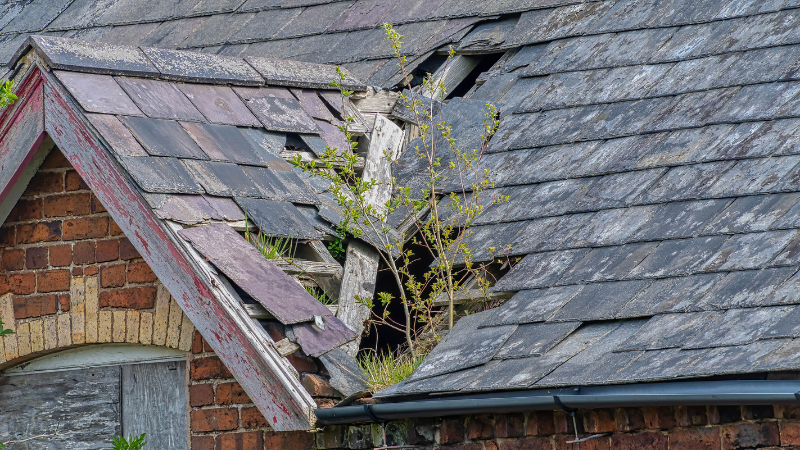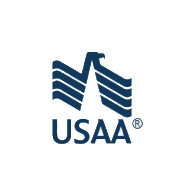Your roof is meant to protect your home from the elements such as rain and wind. Over time, your roof will age and become worn which increases the risk of a roof leak. It is important to get the roof checked for potential damage that could lead to a leak or other issues. Periodic inspections are helpful to catch small issues as opposed to leaving it unnoticed and having to deal with large scale damage.
Leaky roofs can cause water damage in your home that may lead to mold growth. Mold can contribute to the property damage, and it is a risk to your health. It is important take steps to prevent roof leaks that can cause water damage and mold.
Table of Contents
Lifespan of a Roof
Roofs are expensive to replace which is why most people would like to have them last as long as possible. Asphalt shingles are the most common type of roofing material in America and are used for about 80% of all new residential construction. It’s easy to see why: They’re inexpensive, easy to install and repair, and they last for decades before needing replacement. The average lifespan of a roof is about 25 years. This means that at some point, you’re going to have to replace it. Depending on how often you have to make repairs, or if your home was built with a durable material, this could be many years away — or it could be soon.
However, if your roof starts leaking when it rains, it is important to get the shingles replaced. Leaks happen due to uneven wear from sun damage, exposure to wind, and sometimes even due to bad installation. When there is a problem, you may have to replace parts of the roof or the whole thing, depending on the level of damage. Homeowners that live in extreme climates may have to replace their roofs more often. The cost to replace a roof is over $7,000, however the cost can vary significantly.
Maintaining and Caring for your Roof
You should always call a professional contractor to work on your roof when it needs maintenance. Homeowners should keep records of all maintenance done, warranty info, and roof inspection reports. If you notice fallen shingles in your yard, or water leaking inside your home, make sure you have your roof inspected to prevent further damage. A professional roofing company will help you determine where the leaks are coming from. These are the steps you can expect from a roof inspection:
- Your roof will be visually inspected by a roofing professional.
- All the seals around the areas where water could appear will be inspected for damage.
- They will check for shingles that are worn, buckling, or damaged.
As a homeowner, you should make sure to have some exterior maintenance tasks completed so that you can avoid leaks and damage inside your home:
- Your gutters should be cleaned often, if they are not, it can cause roof damage and leaks inside your home.
- Any trees that are close to your home that could possibly fall on the roof should be trimmed or removed.
- Make sure that roof openings are properly sealed. This is especially true for areas around the skylights, chimneys, and vents.
- Always check your attic and areas under the roof where leaks can penetrate.

Signs that Your Roof is Leaking
Roof leaks can happen at any time. If you see a trickle or small damp spot on your ceiling or yellow or brown stains, that may be a sign of a roof leak. It may be difficult to figure out where the water is coming in when there is a leak, and small leaks can lead to large issues such as drywall damage and mold.
Leaks in your roof can have many causes. They can occur due to the age of the roof, or because of damage to the roof that causes water to leak inside. At times, it can be due to improper roof installation and inclement weather such as heavy rains and snowstorms.
Your roof is likely leaking if you notice the following:
- Yellow or brown stains on your ceiling
- Wet spots that may appear on your ceiling or interior walls
- Leaks through windows
- Woodwork that is warped or buckled
- Musty odors that may indicate that you’ve developed mold in your home
Roof Leaks – The Steps you Should Take
If you notice that your roof is leaking, it is important to react quickly to avoid further property damage. If water is leaking inside, put a bucket underneath and make sure that all furniture is moved away from that area. Also, if you notice organic growth on the exterior walls of your home, that may be a sign that your downspout is not working properly and causing a roof leak.
Next, you should work with a contractor to figure out where the leak is coming from. All roofing inspections should be done by professional roofing contractors. They have the proper training and the right equipment to check your roof. They will also help you figure out what you should do if your roof is damaged and what to do to prevent any leaks in the future.
Preventing Mold in Your Home
When the roof is leaking, it can lead to mold within your home. If you leave the mold untreated, it can cause significant damage and trigger health issues. It takes 24-48 hours for mold to develop so it is important to act quickly. Also, if there is drywall damage, there may be damage behind the walls as well that can affect the insulation. Mold can also highly damage the wood under the shingles and cause roof leaks. This is why it is important to get the roof checked for damage by a professional roofing company. If you suspect mold in your home, make sure to schedule a free home inspection from a mold removal company. If they do find mold in your home, they will let you know what it will take to remove it.

Call the Professionals for Mold Removal
Mold can cause major damage in your home. This is why it important to react quickly to prevent it from spreading further and causing additional damage. ServiceMaster by Replacements offers mold remediation services to homes and businesses in Neptune City, New Jersey and the surrounding areas. We will help find the issue that caused the water damage and restore the damage caused by the water and mold.







